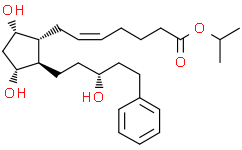| Cas No.: | 130209-82-4 |
| Chemical Name: | Latanoprost |
| Synonyms: | 17-PHENYL-13,14-DIHYDRO TRINOR PROSTAGLANDIN F2ALPHA ISOPROPYL ESTER;9ALPHA,11ALPHA,15R-TRIHYDROXY-17-PHENYL-18,19,20-TRINOR-PROST-5Z-EN-1-OIC ACID, ISOPROPYL ESTER;9ALPHA, 11ALPHA, 15S-TRIHYDROXY-17-PHENYL-18,19,20-TRINOR-PROS-5Z-EN-1-OIC ACID, ISOPROPYL ESTER;ISOPROPYL (5Z, 9A,11A,15R)-9,11,15-TRIHYDROXY-17-PHENYL-18,19,20-TRINOR-PROST-5Z-EN-1-OATE;LATANOPROST;XALATAN;(1r-(1-alpha(z),2-beta(r*),3-alpha,5-alpha))--methylethyleste;7-(3,5-dihydroxy-2-(3-hydroxy-5-phenylpentyl)cyclopentyl)-5-heptenoicaci1;phxa41;xa41;isopropyl (5z,9α,11α,15r)-9,11,15-trihydroxy-17-phenyl-18,19,20-trinor-prost-5-en-1-oate;LATANAPROST;5-Heptenoic acid, 7-[(1R,2R,3R,5S)-3,5-dihydroxy-2-[(3R)-3-hydroxy-5-phenylpentyl]cyclopentyl]-, 1-methylethyl ester, (5Z)- (9CI);5-Heptenoic acid, 7-[3,5-dihydroxy-2-(3-hydroxy-5-phenylpentyl)cyclopentyl]-, 1-methylethyl ester, [1R-[1a(Z),2b(R*),3a,5a]]-;Lata prostaglandin;Propan-2-yl 7-[3,5-dihydroxy-2-(3-hydroxy-5-phenyl-pentyl)-cyclopentyl]hept-5-enoate;Xalatan, Isopropyl (5Z,9α,11α,15R)-9,11,15-trihydroxy-17-phenyl-18,19,20-trinor-prost-5-en-1-oate;Xalata;Isopropyl 7-((1R,2R,3R,5S)-3,5-dihydroxy-2-((R)-3-hydroxy-5-phenylpentyl)cyclopentyl)hept-5-enoate;Isopropyl (Z)-7-[(1R,2R,3R,5S)-3,5-dihydroxy-2-[(3R)-3-hydroxy-5-phenylpentyl]cyclopentyl]hept-5-enoate;Latanopros;cGMP Latanoprost;Latanoprost API;Latanoprost ,98% |
| SMILES: | CC(C)OC(=O)CCC/C=C\C[C@@H]1[C@@H](CC[C@@H](O)CCC2=CC=CC=C2)[C@H](O)C[C@@H]1O |
| Formula: | C26H40O5 |
| M.Wt: | 432.6 |
| Purity: | >98% |
| Sotrage: | 2 years -20°C Powder, 2 weeks 4°C in DMSO, 6 months -80°C in DMSO |
| Description: | Latanoprost is an agonist for the FP prostanoid receptor, and lowers intraocular-pressure (IOP). |
| In Vivo: | A single drop of latanoprost results in marked miosis, anterior bowing of the peripheral iris, narrowing of the iridocorneal angle, and shallowing of the anterior chamber of the beagle dog. Following latanoprost, the pupil diameter, ACA, and AOD (means) decreases 84%, 14%, and 16%, respectively[2]. |
| In Vitro: | Benzalkonium chloride latanoprost (BAK-latanoprost) and 0.02% BAK induce significant apoptosis in the apical layers that correlated with the significant decrease of cell viability. Preservative-free latanoprost (PF-latanoprost) slightly decreases cell viability and few apoptotic cells are found in the superficial layers, without reaching statistical significance compared with PBS[1]. Latanoprost (0.1 μM) significantly increases cell viability as compared with control. Meanwhile, 0.1 μM latanoprost results in the obvious promotion of neurite outgrowth similar to ciliary neurotrophic factor (CNTF) and simultaneously increases the levels of p-Akt and p-mTOR expression. Latanoprost can promote neurite outgrowth through an FP receptor-mediated modulation of the PI3K-Akt-mTOR signaling pathway[3]. Latanoprost (0.03 or 0.3 μg/mL) and bimatoprost increase MMP-9 activity by 75% ± 27% and 75% ± 24%, respectively, in human CBSM cells[4]. |
| Cell Assay: | Cellular viability is evaluated in duplicate at 24 hours with the MTT assay. The 3D-HCEs are transferred to 24-well plates containing 300 μL of MTT solution diluted at 0.5 mg/mL in the culture medium, and 300 μL of the same MTT solution is applied on the apical surface of the 3D-HCEs. Reconstituted tissues are incubated for 3 hours at 37°C. Then they are transferred to 24-well plates containing 750-μL isopropanol, and 750-μL isopropanol is added to the apical surface of the 3D-HCEs. The plates are agitated for 2 hours at room temperature before reading the optical density (OD) at 570 nm versus OD 690 nm. The results are expressed as percentages of cell viability (mean ± SD) compared with the negative control (PBS). |
| References: | [1]. Pauly A, et al. In vitro and in vivo comparative toxicological study of a new preservative-free latanoprost formulation. Invest Ophthalmol Vis Sci. 2012 Dec 13;53(13):8172-80. [2]. Tsai S, et al. The effect of topical latanoprost on anterior segment anatomic relationships in normal dogs. Vet Ophthalmol. 2013 Sep;16(5):370-6. [3]. Zheng J, et al. Latanoprost promotes neurite outgrowth in differentiated RGC-5 cells via the PI3K-Akt-mTOR signaling pathway. Cell Mol Neurobiol. 2011 May;31(4):597-604. [4]. Ooi YH, et al. Effect of bimatoprost, latanoprost, and unoprostone on matrix metalloproteinases and their inhibitors in human ciliary body smooth muscle cells. Invest Ophthalmol Vis Sci. 2009 Nov;50(11):5259-65. [5]. B'Ann True Gabelt, et al. Prostaglandin Subtype-Selective and Non-Selective IOP-Lowering Comparison in Monkeys. |

 DC Chemicals' products qualify for U.S. tariff exemptions. We guarantee no price increases due to customs duties and maintain stable supply, continuing to deliver reliable research solutions to our American clients.
DC Chemicals' products qualify for U.S. tariff exemptions. We guarantee no price increases due to customs duties and maintain stable supply, continuing to deliver reliable research solutions to our American clients.





















